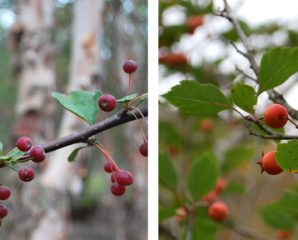Sargent Crabapples (Malus ‘Sargenti’) and Winter King Hawthorns (Crataegus viridis) are great small trees for residential or commercial properties with two season interest – spring for their showy bloom and fall for the red fruits seen here. Malus and Crataegus are both from the same family, Rosaceae (Rose) so have similar features:
Sargent Crabapples grow only 6-8′ tall but can get 9-15′ wide. In April/May they’ll leaf out and produce pink buds opening with white flowers covering the branches – a beautiful sight. Fruit develops late summer and by fall turn bright red. The pea-sized fruit is showy against the yellowing foliage. The small stature makes them useful near patios, in the shrub border, at entryways and even massed. The habit is wide and spreading giving them interest through the winter months. The smaller fruit of the Sargent Crabs are sought after by Robins, Cedar Waxwings and Grosbeaks.
Plant in full sun in average, well-drained soil. It’s tolerant of air pollution and dry soil (once established). Hardy Zones 4-7.
Winter King Hawthorn are on the larger side of small ornamental trees. Also known as the Green Hawthorn, they’ll grow 25-35′ high and about the same in spread. Dark glossy leaves emerge in spring and are followed by clusters of white buds opening to pure white flowers in May. Small fruits develop late summer ripening to red and persists into winter which the birds love. It has great curb appeal and is also a good choice for driveways, home yards and commercial sites. Mature trees develop exfoliating bark, another plus for winter interest.
Plant in full sun to partial shade. It also tolerates air pollution, and wet or dry soil once established. If the site is too moist though, it can cause suckering. Hardy in zone 4-7.
Crabapples and Winter King Hawthorn can be pruned late winter to shape or for size.

